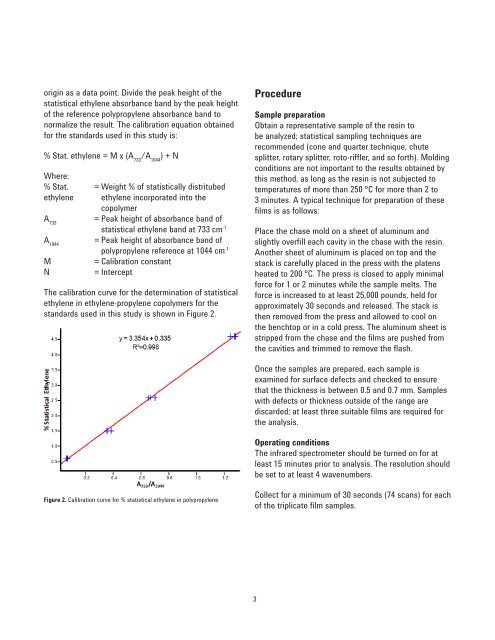Application Compendium - Agilent Technologies
Application Compendium - Agilent Technologies
Application Compendium - Agilent Technologies
You also want an ePaper? Increase the reach of your titles
YUMPU automatically turns print PDFs into web optimized ePapers that Google loves.
origin as a data point. Divide the peak height of the<br />
statistical ethylene absorbance band by the peak height<br />
of the reference polypropylene absorbance band to<br />
normalize the result. The calibration equation obtained<br />
for the standards used in this study is:<br />
% Stat. ethylene = M x (A 733 /A 1044 ) + N<br />
Where:<br />
% Stat. = Weight % of statistically distritubed<br />
ethylene ethylene incorporated into the<br />
copolymer<br />
A = Peak height of absorbance band of<br />
733<br />
statistical ethylene band at 733 cm-1 A 1044<br />
= Peak height of absorbance band of<br />
polypropylene reference at 1044 cm -1<br />
M = Calibration constant<br />
N = Intercept<br />
The calibration curve for the determination of statistical<br />
ethylene in ethylene-propylene copolymers for the<br />
standards used in this study is shown in Figure 2.<br />
Figure 2. Calibration curve for % statistical ethylene in polypropylene<br />
Procedure<br />
Sample preparation<br />
Obtain a representative sample of the resin to<br />
be analyzed; statistical sampling techniques are<br />
recommended (cone and quarter technique, chute<br />
splitter, rotary splitter, roto-riffler, and so forth). Molding<br />
conditions are not important to the results obtained by<br />
this method, as long as the resin is not subjected to<br />
temperatures of more than 250 °C for more than 2 to<br />
3 minutes. A typical technique for preparation of these<br />
films is as follows:<br />
Place the chase mold on a sheet of aluminum and<br />
slightly overfill each cavity in the chase with the resin.<br />
Another sheet of aluminum is placed on top and the<br />
stack is carefully placed in the press with the platens<br />
heated to 200 °C. The press is closed to apply minimal<br />
force for 1 or 2 minutes while the sample melts. The<br />
force is increased to at least 25,000 pounds, held for<br />
approximately 30 seconds and released. The stack is<br />
then removed from the press and allowed to cool on<br />
the benchtop or in a cold press. The aluminum sheet is<br />
stripped from the chase and the films are pushed from<br />
the cavities and trimmed to remove the flash.<br />
Once the samples are prepared, each sample is<br />
examined for surface defects and checked to ensure<br />
that the thickness is between 0.5 and 0.7 mm. Samples<br />
with defects or thickness outside of the range are<br />
discarded; at least three suitable films are required for<br />
the analysis.<br />
Operating conditions<br />
The infrared spectrometer should be turned on for at<br />
least 15 minutes prior to analysis. The resolution should<br />
be set to at least 4 wavenumbers.<br />
Collect for a minimum of 30 seconds (74 scans) for each<br />
of the triplicate film samples.<br />
3

















